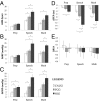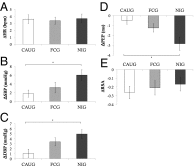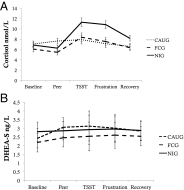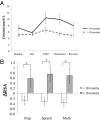Causal effects of the early caregiving environment on development of stress response systems in children
- PMID: 25902515
- PMCID: PMC4426436
- DOI: 10.1073/pnas.1423363112
Causal effects of the early caregiving environment on development of stress response systems in children
Abstract
Disruptions in stress response system functioning are thought to be a central mechanism by which exposure to adverse early-life environments influences human development. Although early-life adversity results in hyperreactivity of the sympathetic nervous system (SNS) and hypothalamic-pituitary-adrenal (HPA) axis in rodents, evidence from human studies is inconsistent. We present results from the Bucharest Early Intervention Project examining whether randomized placement into a family caregiving environment alters development of the autonomic nervous system and HPA axis in children exposed to early-life deprivation associated with institutional rearing. Electrocardiogram, impedance cardiograph, and neuroendocrine data were collected during laboratory-based challenge tasks from children (mean age = 12.9 y) raised in deprived institutional settings in Romania randomized to a high-quality foster care intervention (n = 48) or to remain in care as usual (n = 43) and a sample of typically developing Romanian children (n = 47). Children who remained in institutional care exhibited significantly blunted SNS and HPA axis responses to psychosocial stress compared with children randomized to foster care, whose stress responses approximated those of typically developing children. Intervention effects were evident for cortisol and parasympathetic nervous system reactivity only among children placed in foster care before age 24 and 18 months, respectively, providing experimental evidence of a sensitive period in humans during which the environment is particularly likely to alter stress response system development. We provide evidence for a causal link between the early caregiving environment and stress response system reactivity in humans with effects that differ markedly from those observed in rodent models.
Keywords: HPA axis; autonomic nervous system; childhood adversity; early-life stress; stress reactivity.
Conflict of interest statement
The authors declare no conflict of interest.
Figures




References
-
- Liu D, et al. Maternal care, hippocampal glucocorticoid receptors, and hypothalamic-pituitary-adrenal responses to stress. Science. 1997;277(5332):1659–1662. - PubMed
-
- Plotsky PM, Meaney MJ. Early, postnatal experience alters hypothalamic corticotropin-releasing factor (CRF) mRNA, median eminence CRF content and stress-induced release in adult rats. Brain Res Mol Brain Res. 1993;18(3):195–200. - PubMed
-
- Ladd CO, Owens MJ, Nemeroff CB. Persistent changes in corticotropin-releasing factor neuronal systems induced by maternal deprivation. Endocrinology. 1996;137(4):1212–1218. - PubMed
-
- Sánchez MM, Ladd CO, Plotsky PM. Early adverse experience as a developmental risk factor for later psychopathology: Evidence from rodent and primate models. Dev Psychopathol. 2001;13(3):419–449. - PubMed
-
- Conrad CD, LeDoux JE, Magariños AM, McEwen BS. Repeated restraint stress facilitates fear conditioning independently of causing hippocampal CA3 dendritic atrophy. Behav Neurosci. 1999;113(5):902–913. - PubMed
Publication types
MeSH terms
Substances
Grants and funding
LinkOut - more resources
Full Text Sources
Other Literature Sources
Medical

